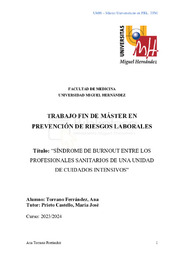Resumen :
Introducción: El “Síndrome de Burnout” o desgaste profesional es una patología que deriva de la interacción del individuo con unas determinadas condiciones psicosociales nocivas en el ambiente de trabajo.
Objetivo: Analizar la prevalencia de Síndrome de Burnout en los profesionales sanitarios de la Unidad de Cuidados Intensivos (UCI) de un hospital de la Región de Murcia.
Métodos: Se realiza un estudio observacional de tipo transversal, en el que se incluyó a todo el personal que ha trabajado durante más de 4 meses en el servicio de forma ininterrumpida, y aquellos profesionales que habían trabajado previamente en UCI y
habían abandonado el puesto en los últimos 4 meses. Los criterios de exclusión fueron
aquellos profesionales parte del servicio volante del hospital, alternando trabajo en UCI
con otras zonas del hospital. La herramienta utilizada para el diagnóstico del síndrome fue el cuestionario Maslach Burnot Inventory (MBI), cuestionario validado para profesionales sanitarios constituido por 22 items en forma de afirmaciones, sobre sentimientos y actitudes del profesional en su trabajo. Se distribuyó la encuesta en mano
a cada uno de los profesionales de la UCI y se recogió de la misma forma, sin que conste ningún otro dato identificativo, ni edad, género ni años trabajados. Únicamente
se preguntó sobre la profesión del encuestado.
Resultados: Se analizaron 96 profesionales, siendo aproximadamente de un 24% del personal el riesgo alto de “Cansancio emocional”, siendo el de “Despersonalización” y
el de “Realización personal”, bajo. Al comparar las subescalas de la encuesta en cada grupo de profesionales, la presencia de frustración, la sensación de pasar demasiado
tiempo en el trabajo y la insensibilidad con los pacientes fue superior en el grupo de los médicos residentes, siendo el riesgo de burnout en este grupo, alto.
Conclusiones: La presencia de síndrome de burnout entre el personal MIR es frecuente,
afectando en torno a un 50% de los encuestados, siendo el riesgo alto de ausencia de realización personal a consecuencia del trabajo, aún más elevado.
Introduction: Burnout syndrome is a pathology that results from the interaction of the individual with certain harmful psychosocial conditions in the work environment.
Objective: To analyze the prevalence of burnout syndrome in healthcare professionals in the Intensive Care Unit (ICU) of a hospital in the Region of Murcia.
Methods: A cross-sectional observational study was carried out, which included all staff who have worked continuously for more than 4 months in the service, and those professionals who have previously worked in the ICU and have left the post in the last 4
months. The exclusion criteria were those professionals who are part of the hospital's mobile service, alternating work in the ICU with other areas of the hospital. The tool used to diagnose the syndrome was the Maslach Burnout Inventory (MBI), a validated
questionnaire for healthcare professionals consisting of 22 items in the form of
statements about the professional's feelings and attitudes in their work. The survey was distributed by hand to each of the ICU professionals and was collected in the same way,
without recording any other identifying data, neither age, gender nor years worked.
Only the profession of the respondent was asked.
Results: 96 professionals were analyzed, with approximately 24% of the staff having a high risk of “Emotional exhaustion”, with “Depersonalization” and “Personal fulfillment” being low. When comparing the subscales of the survey in each group of
professionals, the presence of frustration, the feeling of spending too much time at work
and insensitivity to patients was higher in the group of resident physicians, with the risk
of burnout in this group being high.
Conclusions: The presence of burnout syndrome among MIR staff is frequent, affecting
around 50% of the respondents, with the high risk of lack of personal fulfillment as a result of work being even higher.
|
 La licencia se describe como: Atribución-NonComercial-NoDerivada 4.0 Internacional.
La licencia se describe como: Atribución-NonComercial-NoDerivada 4.0 Internacional.
.png)
